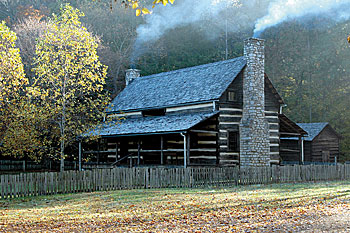With the combination of smoke from woodstoves and the terrain in the area, San Lorenzo Valley now has the dubious distinction of having some of the worst wintertime air quality in the state. It’s a circumstance that we need to address – for our community, for our health, for our air quality, and for our way of life in the Santa Cruz Mountains.
Our valley has a significant air quality problem due to the high concentration of fine particles derived from smoke from woodstoves and fireplaces. The natural topography of the narrow river valley, which includes steep slopes, combined with smoke, leads to the concentration of air pollutants. With cold nights, a temperature inversion is created similar to putting a lid on the valley, which in turn traps the pollutants.

The air quality standards were not exceeded in other parts of the county – which demonstrates the unique circumstances in the San Lorenzo Valley. The peak concentration occurs around midnight, which indicates that the main contributor is woodstoves, which have a damper that has been turned way down for the night. I should point out that outdoor burning was not allowed on the days when the air quality standards were exceeded.
So what can we do? First and most importantly, burn correctly, making small, hot fires with seasoned, dry wood. Don’t let your fire smolder. Don’t burn garbage. Go outside and look at the smoke coming out of the chimney. If you see smoke, your fire may need more air. Don’t overload your woodstove. It won’t burn efficiently. Start your fire with dry kindling or clean newspaper. Don’t use gasoline, kerosene, charcoal or a propane torch. And don’t use those pressed log rolls.
Perhaps most importantly, don’t damper down at night. Many people think they should let a fire smolder overnight. But reducing the air supply does little for heating and increases air pollution. In fact, that’s when air pollution is at its worst in the San Lorenzo Valley.
Don’t damper down; it’s dirty. If your woodstove is too large, you will overheat and be tempted to damper down. It’s better to have the right size stove for your home. And don’t burn in moderate temperatures. You’ll want to damper down, which causes more pollution and wastes wood.
Here are some other steps that are being considered. The Monterey Bay Unified Air Pollution Control District is considering a “change-out” program that would require upgrading a home’s heat source at the point of sale. So, for instance, the owners of a home with only an old, inefficient woodstove would have to install an EPA-approved woodstove or some other heating system when the home is sold.
The Air Pollution Control District has also subsidized installation of pellet stoves for the past several years. While important, this approach is not far-reaching. The air district has pursued voluntary Spare the Air days, in which we have been asked to use alternative heat sources.
My office is also currently exploring a wood voucher program where free clean, seasoned wood would be provided to San Lorenzo Valley residents along with education on best burning practices.
So far, the measures are voluntary. However, if air quality doesn’t improve by 2017, the Environmental Protection Agency may mandate penalties. I don’t want that to happen.
I am confident that we, as a community, can use incentives, education, and courtesy for our neighbors to clean our air.